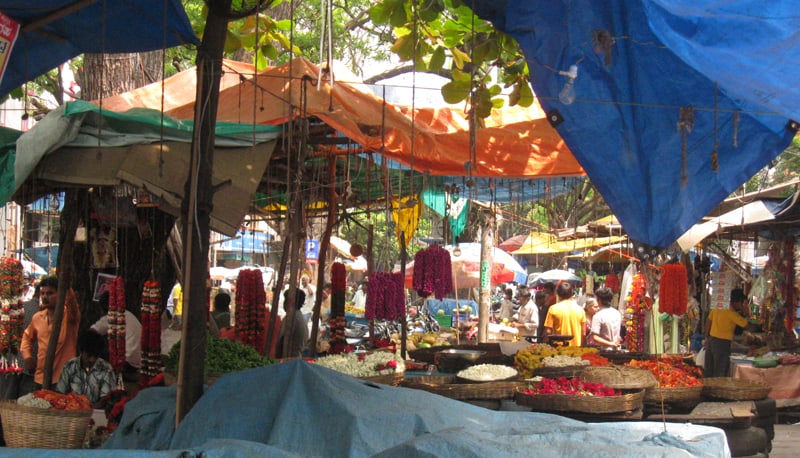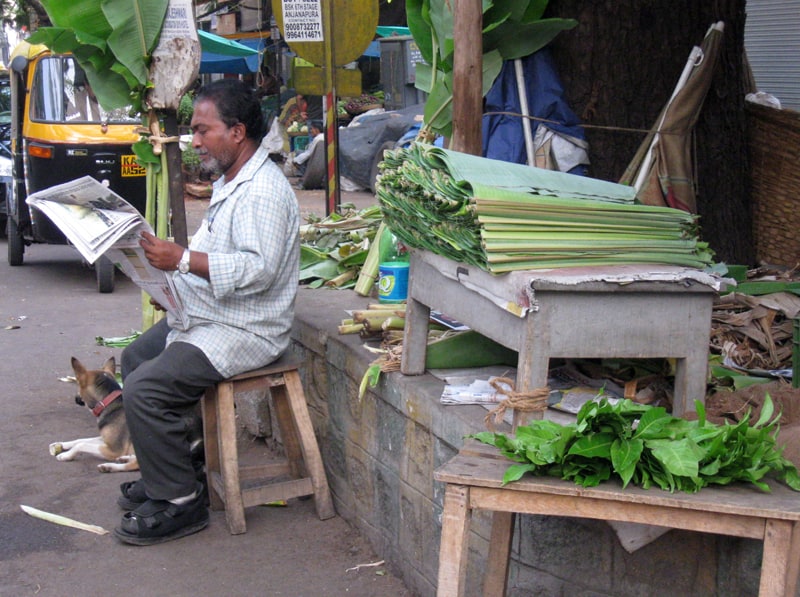There have been recent discussions related to Gandhi Bazaar on converting the Gandhi Bazaar Road to a pedestrian only zone. This note looks at what needs to be considered before making changes to a bazaar road.
The first thing to look at is who uses the road. The user groups in a street bazaar may consist of the ‘shoppers’ who come for a specific purpose; the ‘strollers’ who come to be in the lively space; the ‘shop-owners’, who depend on the activity for their economic sustenance and the ‘hawkers’ who are the informal counterparts.
When does the need arise to pedestrianise a street? Perhaps, when vehicular traffic and pedestrian traffic begin to utilise a common space. This usually happens when the number of pedestrians in a particular zone has increased to a great extent and when the footpath, if it exists is either too narrow or has been occupied for another use.
Once the street vendors create an informal street bazaar, pedestrians gradually start to use the adjoining road to walk and the footpath to shop. This leads to traffic congestion. More often than not, this arrangement continues and both vendors and buyers adjust to the new routine. In this process, there are several stages spread over a period of time that have resulted in a chaotic bazaar street.

Looking through the labyrinth of Flower-sellers in the Gandhi Bazaar. Pic: Kiran Keswani

Gandhi Bazaar and its pattern of boundaries decided by pedestrians and street vendors. When this territory is threatened by cars and two-wheelers, it is informally defended. Pic: Kiran Keswani

A Granthige store (selling puja items) in Gandhi bazaar extends into the sidewalk, expanding its display and building a relationship with the pedestrian. Pic: Kiran Keswani

Livelihoods of street vendors depend on their ability to adapt to the place, the season and the buying capacity of the customer. Pic: Kiran Keswani
At which stage in this process should we bring in a change to ensure the smooth functioning of a growing bazaar? It is possible that as the needs of the public grow and more number of shops are required, we can work towards expanding the existing market, which may be a market-building or a market-street.
Today, most towns and cities find it difficult to improve on existing markets because it is difficult to temporarily relocate the market elsewhere. Within the city, there is often no area available to insert a new market. The available option is usually to relocate them to the peripheral areas which are not so well connected by public transport or even if they are, customers find it tedious to travel large distances for their daily shopping.
With markets, it is almost impossible to start work at any time and put up a board that says, ‘Market closed for repair’. This just won’t work. So, how does one solve this practical problem? This is often the reason for municipalities being unable to improve market zones.
Will pedestrianisation help?
On the other hand, when should the municipal authorities take decisions about a change in urban street vendor policy – including which locations are permissible and which are not; or about which changes in the physical infrastructure can better support the street vendors? It is here that we again ask the question: Will pedestrianisation help? Is it a feasible option? Can the vehicular traffic be diverted elsewhere? Will the shopowners who belong to the formal sector find this acceptable?
For a municipal authority to be able to understand the informal sector, it needs to know more about:
- How a commercial node comes into being?
- How a bazaar grows or evolves over time?
- What are the its demands over the city’s infrastructure?
- What kind of petty trades exist?
- How many of each type thrive here?
- How does the city’s sanitation or traffic get affected with an increase in the number of petty traders?
- Which locations are preferred for what kind of trade?
- What is the distance people are willing to walk to reach a vendor?
- How many petty trades can function together in a common location?
- Their own dependence on other petty trades, such as tea-stalls, food outlets and so on
- The profits they make
- Sources of funding for setting up the trade
- Government schemes that aid them or that are a deterrent in their development
- How many prefer to live and work in the same place?
- Municipal byelaws that benefit them and those byelaws that need to change
An analysis of the petty traders or street vendors in the Gandhi Bazaar area by the municipal authorities, a survey of the vehicular traffic by the transport authorities and a study of pedestrianisation in other parts of India by planners would be useful in the efforts to improve conditions in Gandhi Bazaar.
An example
In Hyderabad, a report prepared for the ‘Revitalisation of the Lad Bazaar’ by S P Shorey, Special Officer Planning, Hyderabad Urban Development Authority (HUDA) emphasises that the conservation and revitalisation of Lad Bazaar is a better solution than road widening and reconstruction for decongesting the Charminar area in Hyderabad. Some of the suggestions in HUDA’s pedestrianisation plan that are also relevant for Gandhi Bazaar are:
- There should be no restriction on cycles and cycle-rickshaws.
- Adequate parking spaces should be provided.
- Bus routes need to be replanned.
- Vehicular traffic in the pedestrian areas will be allowed only before 9 am and after 8 p.
In the case of Lad Bazaar, the major opposition came from the shopowners who feared a loss of business. The report had suggested that the new system be tried on an experimental basis and then lifted or modified as the need arises.
Revitalisation of the Gandhi Bazaar area
For preparing a detailed plan for ‘Revitalisation of the Gandhi Bazaar area’ there are several issues that may need to be studied and discussed amongst the government agencies, the vendors’ associations and the public:
- What are the urban design principles for a market-place in the context of a residential neighbourhood?
- Can the Gandhi Bazaar pedestrian zone also become a tourist attraction? (See related proposals on making the Gavipuram neighbourhood a heritage precinct)
- Would enforcing rules for certain days of the week or for certain times of the day be a more practical solution rather than an overall infrastructural change?
- How is Gandhi Bazaar different from K R Market or Russell Market?
- How many authorised shops exist in Gandhi Bazaar?
- How many street vendors use this space every day?
- What are the key road linkages to the rest of the city?
- In Indian conditions of a relatively warm climate, how can we still benefit from examples of pedestrianisation in western countries?
- Can there be a uniformity of facade for future development in Gandhi Bazaar?
- Can the exhibitions for public at Palace Grounds be studied as an example of existing pedestrianised shopping in Bangalore?
Reporter,
Great job, you have done your homework on the subject. Extensive study on the subject.
Two key points
A reminder to awaken the govt., to begin the task after a brief study on the subject, take residents opinion as well.
2. A wake up call to citizens. Always dont be in an hurry and use auto or vehicle, make use of bus service and please enjoy traveling and shopping as well.